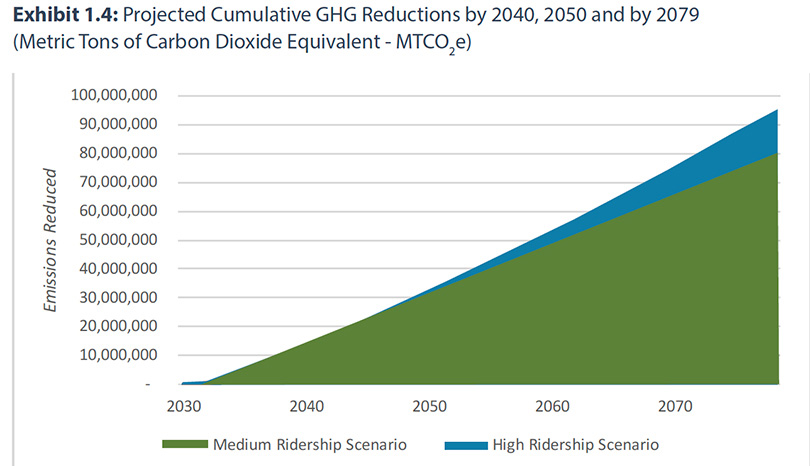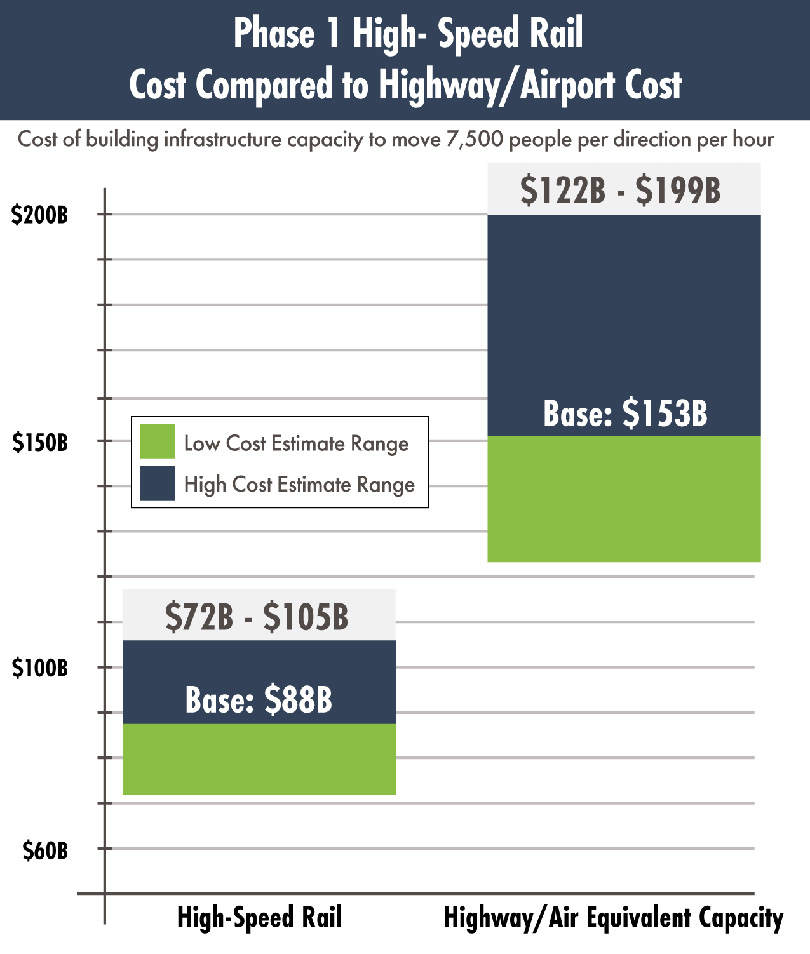California High Speed Rail Advantages
California High-Speed Rail Advantages include higher safety, lower smog & Greenhouse Gas (GHG) emissions, reduced travel times, lower construction costs, and higher capacity than the Highway + Air Travel alternative.
California HSR Safety and Environmental Advantages
Over 2002-08, Californians demanded that state politicians start reducing smog & GHG emissions. As the map below illustrates, California HSR operations will significantly reduce corridor smog & GHG emissions over 2029-50. California HSR will be powered by zero-emission renewable energy.

Massive CO2 reduction over time produced by California High Speed Rail; source California HSR Authority
No Highway + Airport Alternative brings those environmental benefits. A primary proof point is French HSR.
In 1981, France opened HSR infrastructure called “Ligne à Grande Vitesse” (LGV) certified for “Train à Grande Vitesse” (TGV) to reach 205 mph. For safety margin, lower energy consumption and lower maintenence costs, TGV typically runs 10% lower than the certified speed of LGV. Thus, TGV commercially operates up to 186 mph (300 kph) on LGV.
Since opening, the French TGV has had Zero fatalities in commercial operation.
In 2007, France opened Nextgen LGV which is straighter than LGV and certified for high-speed trains to safely reach 249 mph (400 kph). Current generation TGVs were modified to commercially operate up to 199 mph (320 kph) on Nextgen LGV.
Though the TGV option provides more time savings than regional flights up to 3.5 hours, TGV management discovered that train ridership remained high up to 4 hours because so many patrons preferred the central location of stations along with the comfort, and productivity advantages of train travel.
The French train-maker Alstom builds Avelia Horizon, an aerodynamic nextgen high-speed train certified to operate up to 249 mph (400 kph) on Nextgen LGV.
TGV Avelia Horizon features 20% lower energy consumption and lower maintenance cost per mile than the current TGV. France will introduce TGV Avelia Horizon at 199 mph (320 kph) just before the 2024 Paris Summer Olympics as a global PR statement of its commitment to cut GHG & Smog emissions with lower energy consumption required from power plants.
In 2025, Nextgen LGV expands to more cities. My educated guess is that TGV Avelia Horizon will increase to 211 mph (340 kph) to connect more city pairs in 4 hours and reduce regional flights.
Electric trains require thousands of Volts called “kiloVolts” or, to use its acronym, “kV.” High kV is needed to power trains faster. From the outset, French railway engineers specified 25 kV as the standard for overhead wire & electric systems on LGV to support future generations of TGV speeds up to 249 mph.
California high-speed trains, Amtrak Pacific Surfliner & Capitol Corridor regional trains, and Caltrain & Metrolink commuter trains will share tracks in urban areas. Hence, their overhead electric system is/will be constructed for 25 kV like TGV. Conversion of those regional and commuter trains to 25 kV electric power should complete by 2040.
California High-Speed Rail Cost and Capacity Advantages
Over 99% of California HSR infrastructure is being engineered to the same standards as French HSR. To reach the French HSR safety, frequency, and schedule reliability standard, however, all gated railroad crossings should be eliminated via over/underpasses or street closures. At present, California HSR Authority is bowing to local pressure to leave 6 gated railroad crossings at Phase 1 completion.
Unfortunately, many gated railroad crossings slightly lower train safety, frequency, and schedule reliability. HSR advocates like myself hope to better educate the public about the critical need to eliminate all gated railroad crossings.
We live in a country that lacked the willpower to build Amtrak Northeast Corridor HSR correctly, so the rookie California HSR Authority had no experience to draw from in a mega-project of this scale in America. It’s no surprise they suffered well-publicized mistakes.
One of their biggest mistakes was quoting the same $40 billion Base Cost Estimate in 2002 Dollars when the public voted on it in November 2008. An experienced HSR agency would have quoted a $64 billion Base Cost Estimate in 2008 Dollars to voters, due to additional investigation that refined costs and 6 years of inflation to all infrastructure projects, whether they be HSR, Airports, Highways, Rapid Transit, or Power Plants.
A second mistake was that California HSR Authority did not forcefully & repeatedly state that large federal funding is needed to purchase more land, start more engineering design, and enter construction on more simultaneous segments sooner. All three were REQUIRED to minimize inflation on that Base Cost Estimate.
California state government upgraded leadership in California HSR Authority in 2017-18. Now the mega-project is checking off milestones at a faster pace. The 2022 California HSR Business Plan includes best practices to exploit cost-saving opportunities and increase public transparency. Public opinion of the mega-project has improved.
In case you remain among the stubborn critics of California HSR, examine how the Highway-Airport Alternative compares to the California HSR Alternative. Increasing airport capacity for regional flights is the easiest alternative to dismiss.
Eight of the nine busiest California airports have no adjacent open land. Only Sacramento’s SMF Airport has land to expand. SFO Airport and OAK Airport would each have to bay-fill for a runway addition, but voters stand firmly against further shrinkage of San Francisco Bay due to environmental impacts on marine life. San Francisco Bay Area and Los Angeles Metro Area voters also reject more jet noise and smog emissions over their communities. So expanding those eight California airports is not an option.
Building another north-south freeway between San Francisco Bay Area and Los Angeles Metro Area would have been an unmitigated disaster. A freeway would have required 4 times more land-takings than California HSR. It would have required wide highway tunnels and earthmoving through two large mountain ranges. Costs would be twice as high as the California HSR Alternative and induce more driving. Even worst, the added freeway lanes would induce more traffic congestion and parking space demand statewide.

2022 California HSR vs. Highway-Air Estimated Costs include Pandemic Inflation; source: California HSR Authority
The Central Valley spine is designed for 12 trains/hour capacity. Initially, California HSR Authority plans to license a high-speed train operator for 3 trains/hour in an 18-hour workday or 54 trains/day. The San Francisco-Los Angeles segment will have 6 daily Non-Stop roundtrips at 2 hours 40 minutes trip time and 16 daily All-Stop roundtrips at 2 hours 56 minutes trip time. The longest Phase 1 segment, San Francisco-Anaheim, will have 32 Limited-Stop roundtrips in 3 hours 15-minute trip time.
California HSR capacity advantages are immense. Single-deck California HSR trains can start at 500 passengers, which is nearly triple the capacity of a Boeing 737 or Airbus 320 common for regional flights. When demand grows, trains can add cabins and switch to double-deck cabins for up to 900 passengers without expanding station platforms.
Germany, Japan, South Korea, Spain, and China also make nextgen high-speed trains using similar technical standards as TGV. That means California HSR Authority will have a buffet of train makers making competitive bids to become their train(s) of choice.
